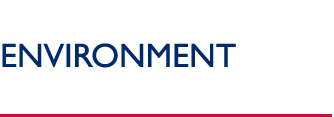USAID/Jamaica’s “Ridge to Reef” Environmental Program
A Partnership to Link Fresh Water and Oceans
Eighty percent of Jamaica’s land surface is described as hilly or mountainous and the upland surface extremely vulnerable to land degradation, erosion, and pollution. Coastal waters are impacted by silt and nutrients which in turn damage coral reefs. Thus the overexploitation of coastal resources — the conversion of forests to other uses and the indiscriminate disposal of waste in industrial and urban areas — impact negatively on both the island’s terrestrial and marine ecosystems. This link between upland watershed and coastal activities and practices, and their combined impact on the quality of Jamaica’s prized coastal waters, was the focus for USAID/Jamaica’s integrated Ridge to Reef Program.
To achieve the objective of improved environmental quality, the Ridge to Reef Program promoted better technologies, policies, and capacity-building for environmental management through three projects:
These projects targeted improvements through activities that attempted to mitigate environmental problems in both the upper and lower watersheds towards positive impacts on the coastal zone. Beneficiaries of program activities included communities and resource users throughout the target watersheds and coastal zones, the Government of Jamaica, private sector entities, and non-governmental and community-based organizations. The USAID/Jamaica Office of the Environment also undertook a number of smaller initiatives, including grants to non-governmental organizations (NGOs) working in environmental management, plus collaborative activities with other U.S. Government technical assistance programs.
The Ridge to Reef Watershed Project (R2RW)
The R2RW project (2000-2005) interventions focused on reducing hillside deforestation, pollution, and land erosion through integrated approaches which address natural and man-made causes of land and water degradation in the two watersheds.
The project utilized a participatory approach to identify and prioritize actions for interventions, and established extensive stakeholder and community consultations to achieve local ownership of the project. R2RW effected significant improvements in watershed management practices at the community level through the establishment of watershed management committees and their associated task forces. At the national level the project was instrumental in establishing mechanisms for more effective communication, coordination, and implementation of watershed management initiatives through the facilitation of the National Integrated Watershed Management Council (NIWMC) and the strengthening of the National Environment and Planning Agency (NEPA)’s Sustainable Watersheds Branch. The project has also worked closely with NEPA’s Compliance and Regional Services Division to improve monitoring and compliance, particularly as it relates to activities within watersheds through public awareness campaigns and sensitization of the local judiciary to the effects of environmental crimes.
The Coastal Water Quality Improvement Project (CWIP)
The CWIP activity (1998-2003) promoted sound environmental practices through integrated coastal zone management, including activities that promote wastewater treatment and solid waste disposal across all sectors of society, and across all levels of government.
In general, the accomplishments of CWIP were exemplary. Community groups were energized to voluntarily undertake a wide array of environmental projects, including water quality sampling, advocating positions on the design and management of wastewater treatment systems, and managing local, small-scale environmental projects, such as solid waste management improvement and recycling projects. Meanwhile, regulatory agencies and resource managers were empowered to better manage coastal zone resources in more transparent and accountable ways.
At the end of phase one, the GOJ and stakeholders requested continued assistance in coastal zone management to build on the outstanding achievements of CWIP. As a result, CWIP-II was initiated and it targeted coastal water quality, but with additional focus on developing integrated management approaches to address water quality issues in Jamaica over the long-term.
The second phase, CWIP-II, developed an integrated parish-level environmental planning and management process in Portland Parish (on the island’s northeastern shore). The intended result was the increased capacity by Portland organizations to lead and influence approaches towards more sustainable planning and management, with an emphasis on strengthening the Parish Council and the Parish Development Committee.
CWIP-II also developed a Blue Flag beach and marina certification program for selected pilot sites, supported by a national water quality monitoring program. The intended result was the successful establishment of a Blue Flag National Coordinating NGO, and certification processes initiated in designated pilot sites.
Environmental Audits for Sustainable Tourism (EAST) Project
The Environmental Audits for Sustainable Tourism activity (1997-2005) promoted improved environmental management practices in the tourism and manufacturing industries in the areas of Ocho Rios, Negril, Montego Bay, and Port Antonio through the adoption of a corporate environmental management system (EMS). Through a series of environmental audits, the project garnered invaluable insights for hoteliers, hospitality training institutions, and a number of manufacturers in identifying and implementing environmental best management practices.
The project was successful in:
- Conducting environmental audits: This includes 36 audits in the tourism sector (including hotels and attractions) and 5 audits in manufacturing entities which supply the tourism sector during the last two years;
- Developing and facilitating implementation of the “green” curriculum at Runaway Bay HEART Hotel and Training Institute, as well as 2 EMS training courses for the hotels and attractions sectors;
- Convening a Green Hotel Conference and Educational Symposium in 2002 to facilitate the exhibition of “green” goods and services and expansion of eco-consciousness in the hospitality training curriculum;
- Providing institutional support towards the development of Runaway Bay Institute as a center for education in Sustainable Development; and
- Developing a model for improved environmental practices which is being adopted regionally and globally (e.g., in the Caribbean, South and Central America, Egypt, and Fiji).
For the remainder of the project, EAST focused primarily on:
- Facilitating the transfer of lessons learned from the first phase of the project to other businesses in Jamaica and the wider Caribbean through USAID’s Regional Environment Program;
- Working with tertiary institutions (e.g., HEART and University of West Indies) to include best management practices in tourism education curricula; and
- Developing and implementing a pilot plan for Port Antonio/Portland as a model for a green tourism destination program.
Back to Top ^
|


